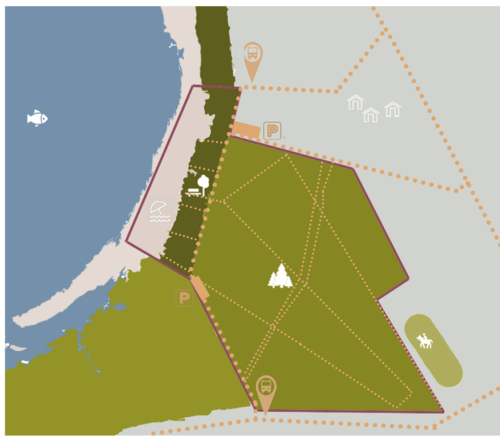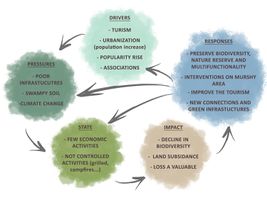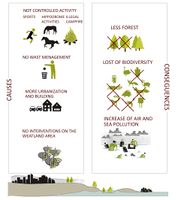Case Study A: Merimetsa-Stroomi: Difference between revisions
| Line 132: | Line 132: | ||
<gallery caption=" " widths="500px" heights="200px" perrow="5"> | <gallery caption=" " widths="500px" heights="200px" perrow="5"> | ||
File: | File:MerimetsaDPSIRmodel.jpg|''DPSI(R) model that summrizes the landscape system analysis. This model identifies the driving forces, pressures, state and impact of Merimetsa/Stroomi area and the possible responces.'' | ||
</gallery> | </gallery> | ||
Revision as of 23:41, 4 April 2019
>>>back to working groups overview
| Area | Merimetsa/Stroomi | |
| Place | Tallinn | |
| Country | Estonia | |
| Topics | please enter the main coast-related topics here | |
| Author(s) | Please enter your name(s)- optional | |

| ||
Rationale
Merimetsa/Stroomi is an area of the north Tallinn district characterized by a biodiversity to preserve and different kinds of landscape. From the sea to the city, there are Stroomi sandy beach, a park with a marshy area and an urban forest where there is a protected area. Each of them is intended for different uses: there is a bathing beach, play areas for children, grilling areas in the park and path through the woods in the forest. However, many natural barriers make difficult to pass through the different areas. The main challenges are making new connections to integrate the different activities of this area and promoting tourism, but in the same time preserving rich ecosystem, biodiversity and making interventions on the marshy area, in order to avoid further damage in the zone.
Location and scope
A Landscape System Analysis
A.1 Landscape layers and their system context
Geomorphology, landscape units and coastal typology
- Description of evolution, status quo and driving forces, is the coastal typology changing? Why is that? (approx 200 signs)
- add 1-2 graphical representations to the image gallery, you can add more if you like
- Yourcase landscapeunits1.jpg
add a caption
- Yourcase landscapeunits2.jpg
add a caption
Land use
- settlements, infrastructure, agriculture, resource extraction, natural areas, energy production...
- description of evolution, status quo and driving forces, is the land use likely to change? Why is that? (approx 200 signs)
- add 1-2 graphical representations to the image gallery, you can add more if you like
- Yourcase landuse1.jpg
add a caption
- Yourcase landscapeunits2.jpg
add a caption
- Yourcase landscapeunit3.jpg
add a caption
Green/blue infrastructure
The major potential elements of a green/blue infrastructure network are:
- the sea with the costal shore (Stroomi beach & park)
- the Stroomi park with the forest
Change/ disappear? Why?:
The Stroomi beach is a very official place and one of the most popular beaches around Tallin. The water is very flat, though the water is still suitable for swimming. There are several playgrounds, a big trampoline, ball playground, a surf school/ shop, changing cabins, an outdoor fitness area, 2 outdoor cafes and ice cream sale. Besides you can rent sun loungers and pedal cars. In the swimming season there is a coast guard. The Stroomi Park is a very popular barbecue and picnic area.
- The accessability could be improved, but a basic construct is available: there is wheelchair access, public transport ((busline 3, 40, and 48) and access by car (parking area) from each side oft he area. In any case, the area is easily accessible for many people and is highly frequented, especially during the summertime.
- Last year during the summer there there were difficulties with cyanobacteria at the Stroomi beach. Caused of the climate change/ ocean change they covered huge areas on the sea with blue-green foam. It is recommended not to swim, because the cyanobacteria releases toxins. These can irritate skin and eyes or cause nausea.
Actors and stakeholders
- Merimetsa/Stroomi coastal area is part of Tallinn municipality, which is divided into 8 districts. Merimetsa/Stroomi belonging to Põhja-Tallinn district. Each district has its own government that fulfills the functions assigned to them by Tallinn legislation and statutes. The changes in the landscape are mostly driven by them. The 48 hectares big nature reserve on the project area is ruled by the Ministry of Environment and owned by the State Forest Management Centre (RMK). The surrounding area has a lot of apartments, so for a lot of people it’s the nearest green space available. There are a lot of local people whose life quality it improves a lot. Right now local people are probably the ones with the least power to make changes. In the future there is a possibility for local people to collaborate with a non-profit organisation called Linnalabor to have a more powerful voice and to improve urban space.
Sacred spaces and heritage
- Which places/elements hold cultural value and to whom?
- You may add a map and some images, please also explain in your caption why these elements are valuable
- Your case sacredspace1.jpg
add a caption
- Your case sacredspace2.jpg
add a caption
- Your case sacredspace3.jpg
add a caption
Visual appearance and landscape narrative
- Which elements are essential for the landscape character?
- Has the landscape been painted or otherwise depicted, when and whom? Which elements are essential?
- Which narratives exist? Who has written about this landscape or depicted it in some way?
- You can add text and images
- Your case character1.jpg
add a caption
- Your case character2.jpg
add a caption
- Your case character3.jpg
add a caption
A.2 Summary of you landscape system analysis and your development Targets
- You can summarize your findings with an DPSI(R) Model or a Spider Diagram
Sustainable Development Goals at risk
- Goal 9: Build resilient infrastructure.
Basic infrastructure like roads, information and communication technologies, electrical power and water remains scarce. This goal is at risk in this area because there are few infrastructures: there are not many throw in the forest; a lot of them realized without an urban plan or a project by the government.
- Goal 11: Make cities inclusive, safe, resilient and sustainable.
Rapid urbanization is exerting pressure on fresh water supplies, sewage, the living environment, and public health. Recently the popularity of this area raised, this zone attracts more local people and tourists but it causes loss of natural heritage because of insufficient infrastructures.
- Goal 12: Ensure sustainable consumption.
Humankind is polluting water in sea faster than nature can recycle and purify and excessive use of water contributes to the global water stress. In this area, this goal is at risk because the sandy beach attractes many tourists and local people that cause pollution with their waste.
- Goal 13: Take urgent action to combat climate change and its impacts.
Global emissions of carbon dioxide (CO2) have increased by almost 50 per cent since 1990. From 1880 to 2012, average global temperature increased by 0.85°C. Oceans have warmed, the amounts of snow and ice have diminished and sea level has risen. This goal is at risk in this area because the growing urbanization and the realization of possible future unsustainable infrastructures will increase in global average temperature.
- Goal 15: Sustainably manage forests, combat desertification, halt and reverse land degradation, halt biodiversity loss.
Forests cover 30.7 per cent of the Earth’s surface and, in addition to providing food security and shelter, they are key to combating climate change, protecting biodiversity. In the urban forest there is the Merimetsa protected area, where are illegal campfires and grilled zones that increase the risk of fire and deforestation. Moreover, the visiting pressure has damaged the soil and destroyed vegetation.
- What is your hypothesis for this landscape?
- Visualise your hypothesis with one graphic/pict
- Are there any existing initiatives taking action in this landscape? Do you have a critical perspective on that?
- Add text and visuals
Both the absent interventions on the marshy area, and the increase of uncontrolled activities, such as those of the Ippodrom, sports and bathing, could damage the natural zone of Merimetsa. It could happen not only because of them but also because of the growth of the city around the forest, which is not all included in the protected area.
A.3 Theory reflection
- Reflect on at least three international policy documents in relation to their local landscape case
- choose one international, one European and one national document
- You can choose references from our reading list
- Scope: 250 words
A.4 References
- https://www.tallinn.ee/est/geoportaal/Rakendused-2
- https://register.metsad.ee/#/
- https://www.riigiteataja.ee/akt/413042017008
- http://register.keskkonnainfo.ee/envreg/main?reg_kood=KLO5000024&mount=view#HTTPG3uSnPzNZWYDzqgNL2BtuBNxZ6BbUX
- https://www.un.org/sustainabledevelopment/sustainable-development-goals/
- Merimetsa kaitseala kaitsekorralduskava 2018-2027
- http://kunilaart.ee/en/artist/paul-burman/
- https://commons.wikimedia.org/wiki/File:Paul_burman_Stroomi.jpg
- https://www.alamyimages.fr/photo-image-environs-de-tallinn-kaart-kava-lestonie-le-reval-ancienne-carte-antique-1912-baedeker-139060518.html
- "https://en.wikipedia.org/wiki/Tallinn"
Phase B: Landscape Evaluation and Assessment
B.1 Assessment Strategy
- Based on the hypothesis derived from your previous landscape systems analysis you are now asked to define the goals for assessing the landscape. Your assessment is the basis for evaluating the landscape status.
- Which elements and phenomena need to be mapped, why and how?
- This a text contribution, max 250 words
B.2 Mapping
- As defined by your assessment strategy you conduct the mapping and present your findings here
- As a minimum, at least three different themes need to be mapped, you may choose more if needed
- Your case your assessment mapping themel.jpg
briefly explain the findings of your mapping
- Your case your assessment mapping theme2.jpg
briefly explain the findings of your mapping
- Your case your assessment mapping theme3.jpg
briefly explain the findings of your mapping
B.3 Problem definition and priority setting
- Give a summary of the major findings of your mapping process, what are the problems/potentials identified?
- Draw a problems/potentials map
- Set priorities for the most relevant issues
- Your case problems potentials map.jpg
add caption here
B.4 Theory reflection
- Please reflect the assessment and evaluation methods used based on at least three readings
- Did you encounter limitations'
- 200 words test contribution
B.5 References
- give a full list of the references you have used for this section
Phase C – Strategy and Master Plan
C.1 Goal Setting
- Define strategic planning objectives based on the evaluation findings
- Link back to your original targets from section one and the Development Goals
- 150 words text contribution
C.2 Spatial Strategy and Transect
- translate your strategic goals into a vision
- develop a spatial translation of your vision
- exemplify your vision in the form of a transect with concrete interventions
- add map(s) and visualizations
- Your case spatial translaton vision.jpg
add caption here
- Your case transect.jpg
add caption here
- Your case transect detail1.jpg
add caption here
- Your case transect detail2.jpg
add caption here
C.3 From Theory of Change to Implementation
- For implementing your vision: Which partnerships are needed? Which governance model is required?
- Who needs to act and how? Draw and explain a change/process model/timeline
- Which resources are needed? On which assets can you build?
- add 150 words text and visuals
- Your case spatial your governance model.jpg
add caption here
- Your case spatial your process model.jpg
add caption here
C.4 References
- give a full list of the references you have used for this section
D. Process Reflection
- Reflect in your intercultural and interdisciplinary team on the outcomes of your study
- Which limitations were you facing?
- What have you learnt from each other?
- What would you do differently next time?
- You can also use diagrams/visuals
- 250 words text



